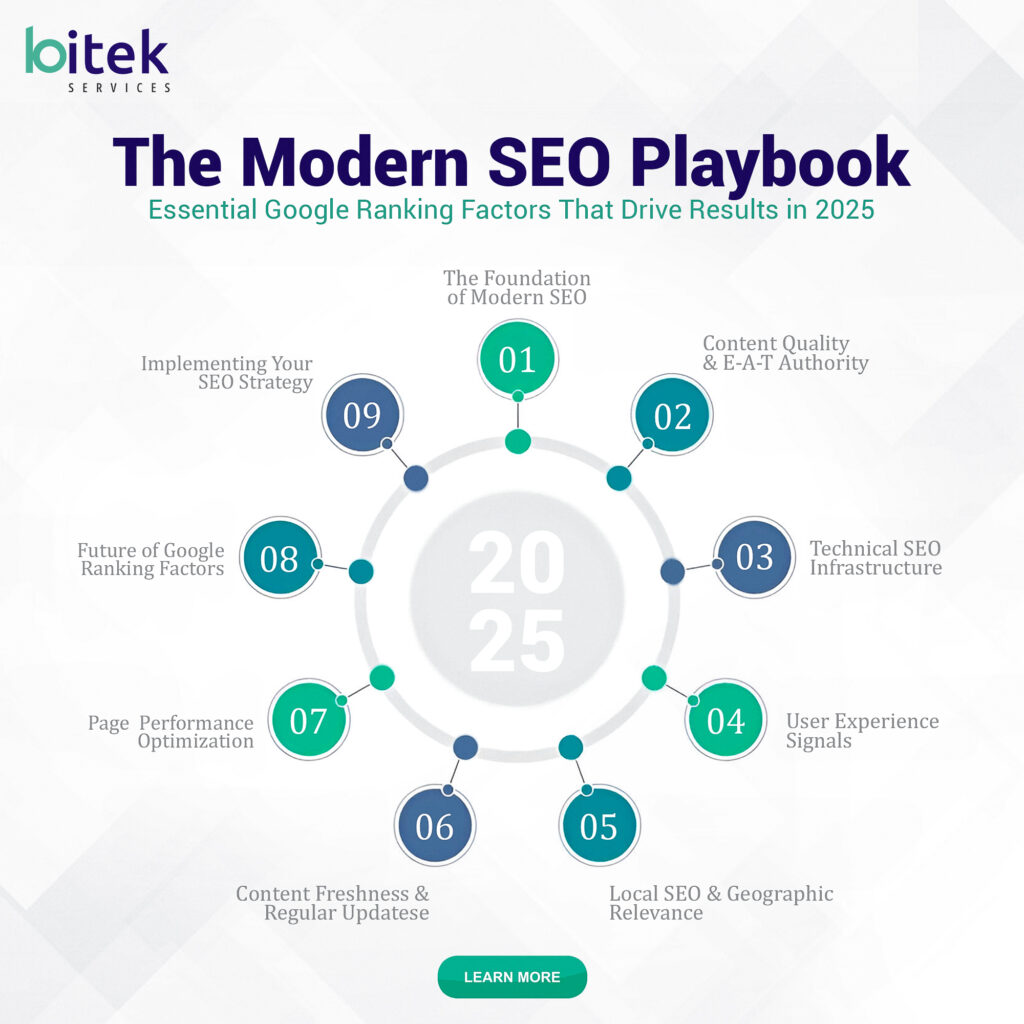In the ever-evolving landscape of digital marketing, understanding Google’s ranking factors has become crucial for businesses seeking online visibility. At BitekServices, we’ve witnessed firsthand how the search giant’s algorithm updates continue to reshape the SEO landscape, making it essential for companies to stay ahead of the curve.
Google processes over 8.5 billion searches daily, and with more than 200 ranking factors influencing search results, knowing which elements truly matter can mean the difference between page one visibility and digital obscurity. Let’s explore the ranking factors that are making the biggest impact right now.
Core Web Vitals: The Foundation of Modern SEO
Google’s Core Web Vitals have transformed from nice-to-have metrics into essential ranking signals. These user-centric performance indicators focus on three critical aspects of user experience:
Largest Contentful Paint (LCP) measures loading performance, with Google expecting your largest content element to load within 2.5 seconds. This directly impacts how quickly users can engage with your content.
First Input Delay (FID) evaluates interactivity, requiring pages to respond to user interactions within 100 milliseconds. A slow response time often leads to frustrated users who abandon your site.
Cumulative Layout Shift (CLS) addresses visual stability, ensuring your page elements don’t unexpectedly shift during loading. Pages with a CLS score below 0.1 provide the smooth browsing experience Google rewards.
Content Quality and E-A-T Authority
Google’s emphasis on Expertise, Authoritativeness, and Trustworthiness (E-A-T) has never been stronger. The search engine prioritizes content that demonstrates deep subject matter knowledge and comes from credible sources.
Creating comprehensive, well-researched content that addresses user intent completely gives you a significant advantage. Google’s algorithms can now better understand context and semantic relationships, meaning surface-level content rarely achieves top rankings.
Original research, case studies, and data-driven insights particularly resonate with Google’s quality guidelines. When your content provides unique value that users can’t find elsewhere, search engines take notice.
Technical SEO Infrastructure
Your website’s technical foundation plays a pivotal role in how Google crawls, indexes, and ranks your content. Several technical factors demand immediate attention:
Mobile-First Indexing means Google primarily uses your mobile version for indexing and ranking. With mobile traffic accounting for over 60% of web browsing, a responsive, mobile-optimized site isn’t optional.
HTTPS Security remains a confirmed ranking factor. Google has made it clear that secure websites receive preferential treatment, and users increasingly expect encrypted connections.
Site Architecture and Internal Linking help Google understand your content hierarchy and distribute page authority throughout your site. A logical structure with strategic internal links can significantly boost your rankings.
User Experience Signals
Google’s RankBrain algorithm incorporates user behavior signals to evaluate content quality. These engagement metrics provide insight into how well your content satisfies searcher intent:
Dwell Time measures how long users stay on your page after clicking from search results. Longer dwell times suggest your content effectively addresses user queries.
Click-Through Rates (CTR) from search results indicate how compelling your titles and meta descriptions are. Higher CTRs signal to Google that users find your content relevant.
Bounce Rate reflects whether users quickly leave your site after arriving. While not a direct ranking factor, high bounce rates often correlate with poor user experience.
Local SEO and Geographic Relevance
For businesses serving specific geographic areas, local SEO factors have become increasingly important. Google My Business optimization, local citations, and location-based content can dramatically improve visibility for location-specific searches.
Consistent NAP (Name, Address, Phone) information across all online platforms builds trust with both users and search engines. Customer reviews and ratings also influence local search rankings significantly.
Content Freshness and Regular Updates
Google values fresh, updated content, particularly for topics where information changes frequently. Regular content updates signal to search engines that your site remains active and relevant.
However, freshness doesn’t mean constantly publishing new content. Updating existing high-performing content with new information, statistics, or insights can be more effective than creating entirely new pages.
Page Speed and Performance Optimization
Site speed continues to be a crucial ranking factor, with Google explicitly stating that faster sites provide better user experiences. Several performance elements directly impact your rankings:
Server Response Time should ideally be under 200 milliseconds. Slow servers create bottlenecks that affect every aspect of your site’s performance.
Image Optimization through compression, proper formatting, and lazy loading can dramatically improve load times without sacrificing visual quality.
Browser Caching and content delivery networks (CDNs) help serve your content faster to users worldwide, improving both user experience and search rankings.
The Future of Google Ranking Factors
As artificial intelligence and machine learning continue to evolve, Google’s ranking algorithms become more sophisticated in understanding user intent and content quality. The search engine increasingly prioritizes websites that provide genuine value to users over those that simply check technical boxes.
Voice search optimization, featured snippet targeting, and AI-generated content guidelines are emerging as important considerations for forward-thinking SEO strategies.
Implementing Your SEO Strategy
Success in modern SEO requires a holistic approach that addresses technical performance, content quality, and user experience simultaneously. At BitekServices, we’ve seen that businesses focusing on these core areas consistently outperform competitors who rely on outdated SEO tactics.
The key is to prioritize user experience while ensuring your technical foundation supports your content marketing efforts. Google’s ranking factors will continue to evolve, but websites that focus on providing exceptional user value will always have a competitive advantage.
Remember, SEO is not a one-time effort but an ongoing process of optimization and refinement. By understanding and implementing these current ranking factors, you’re positioning your business for long-term search success in an increasingly competitive digital landscape.
Ready to optimize your website for Google’s current ranking factors? BitekServices specializes in comprehensive SEO strategies that drive measurable results. Contact us today to learn how we can help your business achieve better search visibility and attract more qualified leads through strategic SEO implementation.





